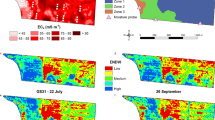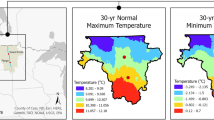Abstract
The net primary productivity is one of the main indicators of an ecosystem’s health. The objectives of the present study were to assess the performance of machine learning techniques in net primary productivity modeling and to assess regional trends for the Brazilian territory. Net primary production was modeled using evapotranspiration estimates, the normalized difference vegetation index, hypsometry and meteorological data. The models adopted for estimating net primary productivity were stepwise regression, Bayesian regularized neural network and Cubist regression. A linear trend model was applied pixel by pixel in order to verify a significant change in net primary productivity across the Brazilian territory. The Cubist model performed best among the evaluated models, with root-mean-squared error of 135.6 g C m−2 year−1 and R2 equal to 0.78. While assessing the net primary productivity time series, an increased trend was observed for the Brazilian Savannah biome, which may be attributed to the replacement of some Savannah formations and degraded grasslands to agriculture. The developed model has shown a great potential for filling the gap of spatial net primary productivity data in large scales.







Similar content being viewed by others
References
Akaike, H. (1974). A new look at the statistical model identification. IEEE Transactions on Automatic Control, 19(6), 716–723.
Almeida, W. S., & Souza, N. M. (2008). Coari: petróleo e sustentabilidade–um exemplo Amazônico. Desenvolvimento e Meio Ambiente, 17.
Alvares, C. A., Stape, J. L., Sentelhas, P. C., de Moraes Gonçalves, J. L., & Sparovek, G. (2013). Köppen’s climate classification map for Brazil. Meteorologische Zeitschrift, 22(6), 711–728. https://doi.org/10.1127/0941-2948/2013/0507.
Araújo, M. A. R., & Coelho, R. M. P. (1998). Produção e consumo de carbono orgânico na comunidade planctônica da represa da Pampulha, Minas Gerais, Brasil. Revista Brasileira de Biologia, 58(3), 405–416. https://doi.org/10.1590/S0034-71081998000300006.
Bao, G., Bao, Y., Qin, Z., Xin, X., Bao, Y., Bayarsaikan, S., et al. (2016). Modeling net primary productivity of terrestrial ecosystems in the semi-arid climate of the Mongolian Plateau using LSWI-based CASA ecosystem model. International Journal of Applied Earth Observation and Geoinformation, 46, 84–93.
Bragança, A. (2018). The economic consequences of the agricultural expansion in Matopiba. Revista Brasileira de Economia, 72(2), 161–185.
Brokamp, C., Jandarov, R., Rao, M. B., LeMasters, G., & Ryan, P. (2017). Exposure assessment models for elemental components of particulate matter in an urban environment: A comparison of regression and random forest approaches. Atmospheric Environment, 151, 1–11.
Cao, M., Prince, S. D., Small, J., & Goetz, S. J. (2004). Remotely sensed interannual variations and trends in terrestrial net primary productivity 1981–2000. Ecosystems, 7(3), 233–242.
Cunha, A. P. M. A., Alvalá, R. C. S., & Oliveira, G. S. (2013). Impactos das mudanças de cobertura vegetal nos processos de superfície na região semiárida do Brasil. Revista Brasileira de Meteorologia, 28(2), 139–152.
Dalmago, G. A., da Cunha, G. R., Santi, A., Pires, J. L. F., & Schweig, E. (2008). Produtividade primária líquida do ambiente natural-indicador de sustentabilidade de sistemas de produção agrícola. Embrapa Trigo-Documentos (INFOTECA-E).
Domingues, M. S., & Bermann, C. (2012). O arco de desflorestamento na Amazônia: da pecuária à soja. Ambiente & sociedade, 15(2), 1–22.
dos Santos, D. B., Silva, D. C. C., & Rodrigues, M. (2016). Instituições e enforcement na redução do desmatamento na Amazônia. Revista Teoria e Evidência Econômica. https://doi.org/10.5335/rtee.v22i47.6831
Foley, J. A., Prentice, I. C., Ramankutty, N., Levis, S., Pollard, D., Sitch, S., et al. (1996). An integrated biosphere model of land surface processes, terrestrial carbon balance, and vegetation dynamics. Global Biogeochemical Cycles, 10(4), 603–628. https://doi.org/10.1029/96GB02692.
Galvíncio, J. D., Naue, C. R., Angelotti, F., & de Moura, M. S. B. (2011). Vitis vinifera spectral response to the increase of CO2. Journal of Hyperspectral Remote Sensing, 1(1), 1–18.
Gomes, L. C., Faria, R. M., de Souza, E., Veloso, G. V., Schaefer, C. E. G. R., & Filho, E. I. F. (2019). Modelling and mapping soil organic carbon stocks in Brazil. Geoderma, 340, 337–350. https://doi.org/10.1016/j.geoderma.2019.01.007.
Guilherme, A. P., Mota, A. B. dos S., Mota, D. dos S., Machado, N. G., & Biudes, M. S. (2016). Uso de índice de vegetação para caracterizar a mudança no uso do solo em Coari-AM. Sociedade & Natureza, 28(2).
IBGE - Instituto Brasileiro de Geografia e Estatística. (2011). Dados gerais do município. http://cidades.ibge.gov.br/painel/painel.php?codmun=130120. Accessed June 22, 2018
Im, J., Lu, Z., Rhee, J., & Quackenbush, L. J. (2012). Impervious surface quantification using a synthesis of artificial immune networks and decision/regression trees from multi-sensor data. Remote Sensing of Environment, 117, 102–113. https://doi.org/10.1016/j.rse.2011.06.024.
Liu, S., Kaire, M., Wood, E., Diallo, O., & Tieszen, L. L. (2004). Impacts of land use and climate change on carbon dynamics in south-central Senegal. Journal of Arid Environments, 59(3), 583–604.
MapBiomas. (2018). Projeto de Mapeamento Anual da Cobertura e Uso do Solo no Brasil [Annual Mapping Project for Land Cover and Use in Brazil]. MapBiomas v3.0. http://mapbiomas.org/map#coverage
Massmann, C. (2015). Supporting M5 model trees with sensitivity information derived from conceptual hydrological models. Journal of Hydroinformatics, 17(6), 943–958. https://doi.org/10.2166/hydro.2015.111.
Morais, Y. C. B., Araújo, M. S. B., Moura, M. S. B., Galvíncio, J. D., & Miranda, R. Q. (2017). Analysis of carbon sequestration in Caatinga areas of Pernambucano Semiarid. Revista Brasileira de Meteorologia, 32(4), 585–599.
Peixoto, A. R., & Costa, C. S. B. (2004). Produção primária líquida aérea de Spartina densiflora Brong. (Poaceae) no estuário da laguna dos Patos, Rio Grande do Sul, Brasil. Iheringia. Série Botânica., 59(1), 27–34.
Pfaff, A., Robalino, J., Walker, R., Aldrich, S., Caldas, M., Reis, E., et al. (2007). Road investments, spatial spillovers, and deforestation in the Brazilian Amazon. Journal of Regional Science, 47(1), 109–123. https://doi.org/10.1111/j.1467-9787.2007.00502.x.
Potter, C., Klooster, S., Huete, A., Genovese, V., Bustamante, M., Guimaraes Ferreira, L., et al. (2009). Terrestrial carbon sinks in the Brazilian Amazon and Cerrado region predicted from MODIS satellite data and ecosystem modeling. Biogeosciences, 6(6), 937–945. https://doi.org/10.5194/bg-6-937-2009.
Quinlan, J. R. (1992). Learning with continuous classes. In 5th Australian joint conference on artificial intelligence (Vol. 92, pp. 343–348). Singapore.
Silveira, M. C. (2013). Variabilidade na produção primária líquida em modelos de superfície para sítios sul-americanos (Master’s thesis). Santa Maria, RS: Federal University of Santa Maria.
Sun, R., Chen, J. M., Zhu, Q., Zhou, Y., Liu, J., Li, J., et al. (2004). Spatial distribution of net primary productivity and evapotranspiration in Changbaishan Natural Reserve, China, using Landsat ETM + data. Canadian Journal of Remote Sensing, 30(5), 731–742.
Ticknor, J. L. (2013). A Bayesian regularized artificial neural network for stock market forecasting. Expert Systems with Applications, 40(14), 5501–5506. https://doi.org/10.1016/j.eswa.2013.04.013.
Verrelst, J., Munõz, J., Alonso, L., Delegido, J., Rivera, J. P., Camps-Valls, G., et al. (2012). Machine learning regression algorithms for biophysical parameter retrieval: Opportunities for Sentinel-2 and -3. Remote Sensing of Environment, 118, 127–139. https://doi.org/10.1016/j.rse.2011.11.002.
Wang, L., Kisi, O., Hu, B., Bilal, M., Zounemat-Kermani, M., & Li, H. (2017). Evaporation modelling using different machine learning techniques. International Journal of Climatology, 37, 1076–1092. https://doi.org/10.1002/joc.5064.
Yang, F., Ichii, K., White, M. A., Hashimoto, H., Michaelis, A. R., Votava, P., et al. (2007). Developing a continental-scale measure of gross primary production by combining MODIS and AmeriFlux data through Support Vector Machine approach. Remote Sensing of Environment, 110(1), 109–122. https://doi.org/10.1016/j.rse.2007.02.016.
Zhang, R., Zhou, Y., Luo, H., Wang, F., & Wang, S. (2017). Estimation and analysis of spatiotemporal dynamics of the net primary productivity integrating efficiency model with process model in karst area. Remote Sensing, 9(5), 477.
Author information
Authors and Affiliations
Corresponding author
Ethics declarations
Conflict of interest
The authors declare that they have no conflict of interest.
Additional information
Publisher's Note
Springer Nature remains neutral with regard to jurisdictional claims in published maps and institutional affiliations.
About this article
Cite this article
Bazame, H.C., Althoff, D., Filgueiras, R. et al. Modeling the Net Primary Productivity: A Study Case in the Brazilian Territory. J Indian Soc Remote Sens 47, 1727–1735 (2019). https://doi.org/10.1007/s12524-019-01024-3
Received:
Accepted:
Published:
Issue Date:
DOI: https://doi.org/10.1007/s12524-019-01024-3




